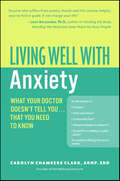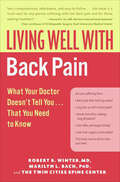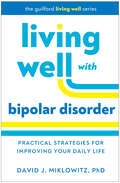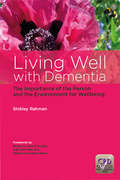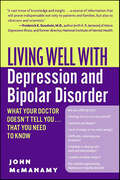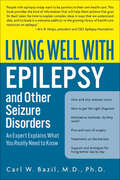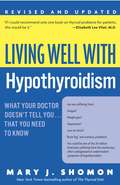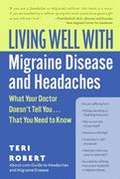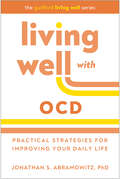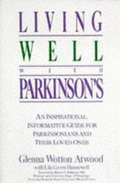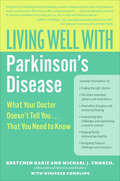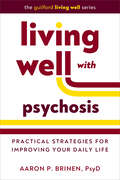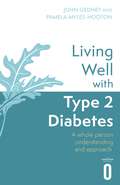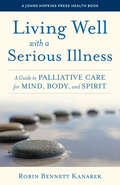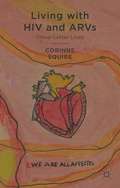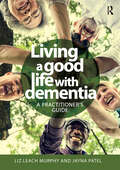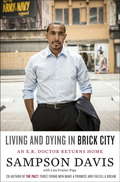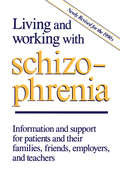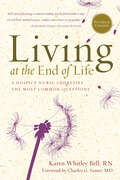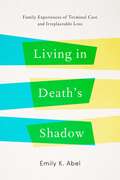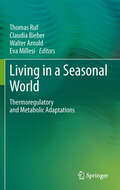- Table View
- List View
Living Well with Anxiety: What Your Doctor Doesn't Tell You . . . That You Need to Know (Living Well)
by Carolyn Chambers ClarkA complete guide to the side-effects and treatments for anxiety disordersHigh anxiety is an unfortunate byproduct of this world, and for approximately 20 million American adults a year, anxiety becomes a debilitating part of their lives. The psychological can become physical, causing dizziness, stammering, heart palpitations, trembling, shaking, and other symptoms. Unlike other books on anxiety disorders, Living Well with Anxiety offers a holistic approach to minimizing anxiety, presenting both conventional psychiatric and psychological approaches to anxiety conditions, as well as patient anecdotes, and nutrition, herbal, environmental, exercise and other healing measures to combat this disorder. Living Well with Anxiety contains helpful advice for a wide range of anxiety disorders, including social anxiety disorder, panic disorder, obsessive compulsive disorder and various phobias that cause anxiety. With a comprehensive resource section that contains websites, doctors, and helpful articles, this book, like all of the titles in the successful Living Well series, offers positive and far-reaching solutions to building a healthier life, both emotionally and physically.
Living Well with Back Pain: What Your Doctor Doesn't Tell You . . . That You Need to Know
by Marilyn L. Bach Robert B. Winter Twin Cities Spine CenterIf you're one of the millions of Americans suffering from back pain, Robert B. Winter, MD, and Marilyn L. Bach, PhD, have the answers and knowledge you need to effectively manage your condition. In Living Well with Back Pain, Winter and Bach draw on an extensive network of experts to bring you the latest information on:Diagnosing—and even eliminating—the problemExercise programs and over-the-counter drug treatmentsChoosing the right medical practitionerWhen surgery and other invasive procedures are not neededThe authors are affiliated with an internationally renowned back treatment center, the Twin Cities Spine Center, which has treated tens of thousands of back pain sufferers. Their expertise and up-to-the-minute knowledge make this the most comprehensive, current, and accessible back pain book available.
Living Well with Bipolar Disorder: Practical Strategies for Improving Your Daily Life (Guilford Living Well Series)
by David J. MiklowitzWhat does it take to achieve a successful career, healthy habits, and fulfilling relationships--even with bipolar disorder (BD)? What common stressors do you need to look out for, and how can you cope with them? No one is better suited to provide people with BD with practical problem-solving help than leading expert David J. Miklowitz. From managing mood swings to dealing with anxiety, getting enough sleep, defusing family conflicts, and troubleshooting medications, this book offers keys to effective self-care. Short, clearly formatted chapters with downloadable practical tools help you tackle challenges as they arise and plan for trouble spots that lie ahead. With Dr. Miklowitz's empowering guidance, navigate your own unique path to living well.
Living Well with Chronic Illness
by Committee on Living Well Chronic Disease: Public Action to Reduce Disability Improve Functioning Quality Of LifeIn the United States, chronic diseases currently account for 70 percent of all deaths, and close to 48 million Americans report a disability related to a chronic condition. Today, about one in four Americans have multiple diseases and the prevalence and burden of chronic disease in the elderly and racial/ethnic minorities are notably disproportionate. Chronic disease has now emerged as a major public health problem and it threatens not only population health, but our social and economic welfare. Living Well with Chronic Disease identifies the population-based public health actions that can help reduce disability and improve functioning and quality of life among individuals who are at risk of developing a chronic disease and those with one or more diseases. The book recommends that all major federally funded programmatic and research initiatives in health include an evaluation on health-related quality of life and functional status. Also, the book recommends increasing support for implementation research on how to disseminate effective longterm lifestyle interventions in community-based settings that improve living well with chronic disease. Living Well with Chronic Disease uses three frameworks and considers diseases such as heart disease and stroke, diabetes, depression, and respiratory problems. The book's recommendations will inform policy makers concerned with health reform in public- and private-sectors and also managers of communitybased and public-health intervention programs, private and public research funders, and patients living with one or more chronic conditions.
Living Well with Dementia: The Importance of the Person and the Environment for Wellbeing
by Shibley RahmanThis unique guide provides a much needed overview of dementia care. With a strong focus on the importance of patients and families, it explores the multifaceted meaning behind patient wellbeing and its vital significance in the context of national policy.Adopting a positive, evidence-based approach, the book dispels the bleak outlook on dementia ma
Living Well with Depression and Bipolar Disorder: What Your Doctor Doesn't Tell You . . . That You Need to Know
by John McManamySeven years ago, John McManamy was diagnosed with bipolar disorder. Through his successful Web site and newsletter, he has turned his struggles into a lifelong dedication to helping others battling depression and bipolar disorder reclaim their lives. In Living Well with Depression and Bipolar Disorder, he brilliantly blends the knowledge of leading expert authorities with the experiences of his fellow patients, as well as his own, and offers extensive information on:Diagnosing the problemAssociated illnesses and symptomsTreatments, lifestyle, and copingThe effects of depression and bipolar disorder on relationships and sexWith a compassionate and eloquent voice, McManamy describes his belief that depression is a wide spectrum that reaches from occasional bouts of depression to full-fledged bipolar disorder. The first book to help patients recognize this diversity of the disorder, Living Well with Depression and Bipolar Disorder will help sufferers begin to reclaim their lives.
Living Well with Epilepsy and Other Seizure Disorders: An Expert Explains What You Really Need to Know
by Carl W. BazilOffering treatment options, lifestyle strategies and support, this expert health care resource for people living with epilepsy is “a welcome addition” (Eric R. Hargis, President & CEO, Epilepsy Foundation). Epilepsy, once mistakenly associated with demonic possession, has for centuries been a poorly understood illness. Today, though it affects nearly one out of every one hundred Americans, little comprehensive information can be found on bookshelves regarding this common and complex neurological disease. Until now.Using his expertise in pharmacology and neuroscience, Dr. Carl Bazil demystifies epilepsy and other seizure disorders and offers medical, practical, and emotional support to patients and their families. He explains how and why seizures occur, and thoroughly discusses treatment options, the pros and cons of surgery, experimental and alternative treatments, strategies for daily living, and much more.Substantiated with case examples, this useful book provides a much-needed window into epilepsy so that patients can achieve the full life they deserve.
Living Well with Hypothyroidism
by Mary J. ShomonThe Most Comprehensive Resource Available on the Diagnosis and Treatment of Hypothyroidism For millions of Americans, hypothyroidism often goes untreated ... or is treated improperly. This book, thoroughly researched by the nation's top thyroid patient advocate--a hypothyroidism patient herself--provides you with answers to all your questions, including: What is hypothyroidism? What are the warning signs, symptoms, and risk factors? Why is getting diagnosed often a challenge, and how can you overcome the obstacles? What treatments are available (including those your doctor hasn't told you about)? Which alternative and holistic therapies, nutritional changes, and supplements may help treat hypothyroidism?
Living Well with Hypothyroidism
by Mary J. ShomonThe Most Comprehensive Resource Available on the Diagnosis and Treatment of HypothyroidismFor millions of Americans, hypothyroidism often goes untreated ... or is treated improperly. This book, thoroughly researched by the nation's top thyroid patient advocate--a hypothyroidism patient herself--provides you with answers to all your questions, including:What is hypothyroidism?What are the warning signs, symptoms, and risk factors?Why is getting diagnosed often a challenge, and how can you overcome the obstacles?What treatments are available (including those your doctor hasn't told you about)?Which alternative and holistic therapies, nutritional changes, and supplements may help treat hypothyroidism?
Living Well with Hypothyroidism
by Mary J. ShomonThe Most Comprehensive Resource Available on the Diagnosis and Treatment of HypothyroidismFor millions of Americans, hypothyroidism often goes untreated ... or is treated improperly. This book, thoroughly researched by the nation's top thyroid patient advocate--a hypothyroidism patient herself--provides you with answers to all your questions, including:What is hypothyroidism?What are the warning signs, symptoms, and risk factors?Why is getting diagnosed often a challenge, and how can you overcome the obstacles?What treatments are available (including those your doctor hasn't told you about)?Which alternative and holistic therapies, nutritional changes, and supplements may help treat hypothyroidism?
Living Well with Migraine Disease and Headaches: What Your Doctor Doesn't Tell You... That You Need to Know
by Teri RobertFor millions of Americans, Migraine disease, tension headaches, and other headaches are a debilitating part of every day. Teri Robert has been there -- in fact, she experienced her first Migraine at age six. Now, in this groundbreaking holistic guide to the diagnosis and treatment of headaches and Migraine disease, she brings a patient-empowering message to all headache sufferers: you don't have to live with daily pain. She provides you with all the information you need to know about getting the help you need, including: Understanding side effects Treatments for long-term relief Risks and symptoms, Identification of the various types of headaches, Traditional and alternative therapies, Information on finding health care practitioners and support, Numerous case studies and expert advice.
Living Well with OCD: Practical Strategies for Improving Your Daily Life (Guilford Living Well Series)
by Jonathan S. AbramowitzOver decades, noted authority Jonathan S. Abramowitz has helped thousands of people use the best science-based strategies to overcome obsessive–compulsive disorder (OCD). But if you have OCD--whether in treatment or not--you know that some days are harder than others. If you are looking for empathic support to navigate the rough patches when OCD disrupts your life, this book is for you! Get step-by-step ideas and downloadable practical tools for coping with lingering obsessional thoughts and doubts, riding out compulsive urges, and staying on track at work or in school. Dr. Abramowitz offers tips for navigating relationships and solving problems with family members, friends, and romantic partners. In short, engaging chapters, this book helps you cultivate resilience, replace self-criticism with self-compassion, and build the life you want--even with OCD.
Living Well with Parkinson's
by Glenna Wotton Atwood Lila Green HunnewellPractical suggestions for everyday living, nutrition, exercise, attitude, dealing with doctors, medications, therapies, support grou Oneps, organizations in the US and Canada. One of the authors has Parkinson's and tells of her own experiences. No profanity or violence. No explicit sexual words.
Living Well with Parkinson's Disease: What Your Doctor Doesn't Tell You....That You Need to Know
by Winifred Conkling Michael J. ChurchA complete guide to Parkinson’s from two people with the disease who cofounded a national support and advocacy organization.In Living Well with Parkinson’s Disease, Gretchen Garie and Michael J. Church, a couple who both have Parkinson’s and live daily with the effects of the disease, thoroughly discuss diagnosis, treatment options, and the emotional consequences of this difficult illness. With a conversational, pragmatic, and personal tone, they offer advice on such topics as:How Parkinson’s disease affects relationshipsThe role of diet, supplements, and rest and relaxationStrategies for navigating professional life and the maze of the health-care systemHandling everyday challenges such as buttoning a shirt or rolling over in bedAnd more!Compassionate and inspiring, Living Well with Parkinson’s Disease offers knowledge and wisdom from those who understand the challenges of dealing with Parkinson’s every day.“[Gretchen and Michael’s] firsthand knowledge as patients, coupled with their years of experience as experts and advocates, allow them to offer a unique perspective. Using the information provided by Gretchen and Michael in this book, you, too, can live well with Parkinson’s disease.” —John D. Campbell, MD, neurologist and medical director for PASFL, the Parkinson’s Association of Southwest Florida
Living Well with Psychosis: Practical Strategies for Improving Your Daily Life (The Guilford Living Well Series)
by Aaron P. BrinenFor people with psychosis, recovery is a winding path, not a straight line. And the best person to steer your recovery is you. Leading psychologist Aaron P. Brinen busts myths and helps you build the life you want in this empowering book. Dr. Brinen provides step-by-step guidance for becoming a strong self-advocate, navigating treatment options, managing symptoms that cause distress, and coping with stigma. Learn crucial ways to connect with others, pursue your goals at school or work, and keep your body healthy. The brief chapters are warm and compassionate, with downloadable practical tools designed to boost your energy and motivation for getting out into the world. This is a book you can read cover to cover--or dip into any time you need extra support to live well and feel good.
Living Well with Type 2 Diabetes: A Whole Person Understanding and Approach (Living Well)
by Pamela Myles-Hooton Dr John GedneyA practical, self-help guide for living well with Type 2 Diabetes (T2D) In the last forty years, we have seen an astounding rise in the prevalence of T2D in most countries. There are thought to be close to half a billion people affected worldwide. Traditionally thought of as a disease of mid-life and old age, both T2D and the metabolic markers of future disease are now increasingly being seen in young people, children and even infants. The burden of this disease is huge at all levels − for healthcare spend and for added risk of other medical problems. Other than its physical impacts, more than a third of people with T2D are said to experience psychological problems related specifically to the condition. We are now at a crossroads in understanding the science behind T2D with a more focused approach emerging. Research and practice are challenging the traditional way in which we approach and manage T2D − as well as better understanding how to prevent it altogether. By following the advice in this book, you will: · Better understand and be empowered to control your metabolic health · Learn how to prevent, reverse, or improve, and better manage your T2D Living Well self-help guides use clinically proven techniques to treat long-standing and disabling conditions, both psychological and physical.
Living Well with Type 2 Diabetes: A Whole Person Understanding and Approach (Living Well)
by Pamela Myles-Hooton Dr John GedneyA practical, self-help guide for living well with Type 2 Diabetes (T2D) In the last forty years, we have seen an astounding rise in the prevalence of T2D in most countries. There are thought to be close to half a billion people affected worldwide. Traditionally thought of as a disease of mid-life and old age, both T2D and the metabolic markers of future disease are now increasingly being seen in young people, children and even infants. The burden of this disease is huge at all levels − for healthcare spend and for added risk of other medical problems. Other than its physical impacts, more than a third of people with T2D are said to experience psychological problems related specifically to the condition. We are now at a crossroads in understanding the science behind T2D with a more focused approach emerging. Research and practice are challenging the traditional way in which we approach and manage T2D − as well as better understanding how to prevent it altogether. By following the advice in this book, you will: · Better understand and be empowered to control your metabolic health · Learn how to prevent, reverse, or improve, and better manage your T2D Living Well self-help guides use clinically proven techniques to treat long-standing and disabling conditions, both psychological and physical.
Living Well with a Serious Illness: A Guide to Palliative Care for Mind, Body, and Spirit (A Johns Hopkins Press Health Book)
by Robin Bennett KanarekA practical guide for understanding how palliative care can improve quality of life for patients and their caregivers.Robin Bennett Kanarek was a registered nurse working with patients suffering from chronic medical conditions when her ten-year-old son was diagnosed with leukemia. As her son endured grueling treatments, Robin realized how often medical professionals overlook critical psychological, emotional, and spiritual support for people with life-threatening illnesses. Living Well with a Serious Illness is the culmination of decades of Robin's work to advance the field of palliative care.Although palliative care is often associated with hospice and end-of-life planning, Kanarek argues for a more expanded definition that incorporates palliative care earlier in patients' journeys. Living Well with a Serious Illness helps patients and their caregivers understand• what palliative care entails• how to access the support they need when going through a serious illness• what questions to ask medical professionals • how to navigate advanced care planning• definitions of common terminology used with end-of-life planning• the importance of spiritual care, coping strategies, and emotional support• how to become an advocate for palliative careThis book illuminates the importance of seeing patients as individuals who can benefit from care for their body, mind, and spirit—the core tenet of palliative care.
Living With Hiv And Arvs
by Corinne SquireThis book explores the possibilities and difficulties of living with HIV and ARVs, or antiretroviral treatment, today. It draws on HIV-positive people's stories from both the UK and the South African epidemics and offers a deep understanding of the continuing difficulties of living with HIV and the effective strategies for coping that have evolved.
Living a good life with Dementia: A practitioner's guide
by Liz Leach Murphy Jayna PatelA practical guide to helping those living with dementia live their best life in a way that makes sense to them.Essential reading for anyone working with people living with dementia, this book explains the concept of Self-Directed Support and Care for people living with dementia and links the various Person Centred approaches within dementia care with Person Centred Planning and Community based approaches. As the content unfolds, the concept of the Dementia Care Triad (people living with dementia, unpaid carers and professional carers) is explored and developed further to include the layer of community. The links between the health and social care legal context, guidance documents and national dementia strategies are presented with good, actionable practice, approaches, tools and informed advice to achieve Person Centred dementia care and support, with an emphasis on communities Living a Good Life with Dementia will help professionals and carers gain knowledge and insight to be able to develop creative ideas for the care and support they want to have in place.
Living and Dying in Brick City: Stories from the Front Lines of an Inner-City E.R.
by Sampson Davis Lisa Frazier PageA riveting personal exploration of the healthcare crisis facing inner-city communities, written by an emergency room physician who grew up in the very neighborhood he is now serving Sampson Davis is best known as one of three friends from inner-city Newark who made a pact in high school to become doctors. Their book The Pact and their work through the Three Doctors Foundation have inspired countless young men and women to strive for goals they otherwise would not have dreamed they could attain. In this book, Dr. Davis looks at the healthcare crisis in the inner city from a rare perspective: as a doctor who works on the front line of emergency medical care in the community where he grew up, and as a member of that community who has faced the same challenges as the people he treats every day. He also offers invaluable practical advice for those living in such communities, where conditions like asthma, heart disease, stroke, obesity, and AIDS are disproportionately endemic. Dr. Davis's sister, a drug addict, died of AIDS; his brother is now paralyzed and confined to a wheelchair as a result of a bar fight; and he himself did time in juvenile detention--a wake-up call that changed his life. He recounts recognizing a young man who is brought to the E.R. with critical gunshot wounds as someone who was arrested with him when he was a teenager during a robbery gone bad; describes a patient whose case of sickle-cell anemia rouses an ethical dilemma; and explains the difficulty he has convincing his landlord and friend, an older woman, to go to the hospital for much-needed treatment. With empathy and hard-earned wisdom, Living and Dying in Brick City presents an urgent picture of medical care in our cities. It is an important resource guide for anyone at risk, anyone close to those at risk, and anyone who cares about the fate of our cities. Praise for Living and Dying in Brick City "This book just might save your life. Sampson Davis shares fascinating stories from the E.R. and addresses the inner-city health crisis. His book is an important investment in your most valuable resource: your health."--Suze Orman, author of The Money Class "This book is living proof that behind the boarded-up windows of one of America's most neglected cities, beyond the sorrow and the pain, there is much more than we've come to expect. There is hope. There is change. There is redemption for Brick City. The book will open your eyes to a part of the world that most of us only see from behind the wheel of a tightly locked car. Sampson Davis is not afraid to lift heavy objects in this world. I'm glad he shared his journey with us, so that we know it is possible."--James McBride, author of The Color of WaterFrom the Hardcover edition.
Living and Working with Schizophrenia
by Joel J. JeffriesFor the families of schizophrenics, fear, guilt, frustration, and despair can become part of daily life. Several years ago the authors of this volume established a program at the Clarke Institute of Psychiatry in Toronto to help the families of schizophrenics cope with the sometimes debilitating emotions they typically experience. The first edition of Living and Working with Schizophrenia grew out of that program. Published to international acclaim in 1982, it offered practical advice and clear, accessible information to those who suffer from schizophrenia, their relatives, friends, teachers, and employers.This edition has been completely updated and includes entirely new sections and more case vignettes. The authors have expanded the information on family education, counseling, and social issues, addressing such topics as community organizations, adoption, pregnancy, parenting, and sexuality.From the medical perspective, the authors explore in detail diagnosis and prognosis and describe the drugs used in the treatment of schizophrenia, with information on their effects and side-effects. The latest research is taken into account, and all is explained in language readily understood by the lay reader.
Living at the End of Life: A Hospice Nurse Addresses the Most Common Questions
by Karen Whitley BellAn updated edition of the most respected book on hospice care—for both patients and caregivers. This warm and informative resource on hospice and other end-of-life care options now gets an update. It receives a new preface and revised guidance on elders who need more long-term care and support, recommendations on pain medications, and advice for those living extended lives with treatable, but not curable, diseases. Written by a hospice nurse, Living at the End of Life reassures us that this difficult time also offers an opportunity to explore and rediscover a richer meaning in life. Drawing on her years of experience, Bell has created a comprehensive, insightful guide to every aspect of hospice care and the final stages of life. For people in hospice, as well as their friends and families, this is an indispensable and trustworthy source of comfort and spiritual healing.
Living in Death’s Shadow: Family Experiences of Terminal Care and Irreplaceable Loss
by Emily K. AbelChallenging assumptions about caregiving for those dying of chronic illness.What is it like to live with—and love—someone whose death, while delayed, is nevertheless foretold? In Living in Death’s Shadow, Emily K. Abel, an expert on the history of death and dying, examines memoirs written between 1965 and 2014 by family members of people who died from chronic disease. In earlier eras, death generally occurred quickly from acute illnesses, but as chronic disease became the major cause of mortality, many people continued to live with terminal diagnoses for months and even years. Illuminating the excruciatingly painful experience of coping with a family member’s extended fatal illness, Abel analyzes the political, personal, cultural, and medical dimensions of these struggles.The book focuses on three significant developments that transformed the experiences of those dying and their intimates: the passage of Medicare and Medicaid, the growing use of high-tech treatments at the end of life, and the rise of a movement to humanize the care of dying people. It questions the exalted value placed on acceptance of mortality as well as the notion that it is always better to die at home than in an institution. Ultimately, Living in Death’s Shadow emphasizes the need to shift attention from the drama of death to the entire course of a serious chronic disease. The chapters follow a common narrative of life-threatening disease: learning the diagnosis; deciding whether to enroll in a clinical trial; acknowledging or struggling against the limits of medicine; receiving care at home and in a hospital or nursing home; and obtaining palliative and hospice care. Living in Death’s Shadow is essential reading for everyone seeking to understand what it means to live with someone suffering from a chronic, fatal condition, including cancer, AIDS, Alzheimer’s, and heart disease.
Living in a Seasonal World
by Walter Arnold Claudia Bieber Eva Millesi Thomas RufThis book summarises the newest information on seasonal adaptation in animals. Topics include animal hibernation, daily torpor, thermoregulation, heat production, metabolic depression, biochemical adaptations, neurophysiology and energy balance. The contributors to this book present interdisciplinary research at multiple levels ranging from the molecular to the ecophysiological, as well as evolutionary approaches. The chapters of this book provide original data not published elsewhere, which makes it the most up-to-date, comprehensive source of information on these fields. The book's subchapters correspond to presentations given at the 14th International Hibernation Symposium in August 2012 in Austria. This is a very successful series of symposia (held every four years since 1959) that attracts leading researchers in the field. Like the past symposia, this meeting - and consequently the book - is aimed not only at hibernation but at covering the full range of animal adaptations to seasonal environments. For the next four years, this book will serve as the cutting-edge reference work for graduate students and scientists active in this field of physiology and ecology. .
